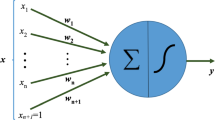Abstract
A constructive algorithm is proposed for feed-forward neural networks which uses node-splitting in the hidden layers to build large networks from smaller ones. The small network forms an approximate model of a set of training data, and the split creates a larger, more powerful network which is initialised with the approximate solution already found. The insufficiency of the smaller network in modelling the system which generated the data leads to oscillation in those hidden nodes whose weight vectors cover regions in the input space where more detail is required in the model. These nodes are identified and split in two using principal component analysis, allowing the new nodes to cover the two main modes of the oscillating vector. Nodes are selected for splitting using principal component analysis on the oscillating weight vectors, or by examining the Hessian matrix of second derivatives of the network error with respect to the weights.
Similar content being viewed by others
References
Wynne-Jones M. Constructive algorithms and pruning: Improving the multi layer perceptron. In: Vichnevetsky R, Miller JJH, editors. Proceedings of the 13th IMACS World Congress on Computation and Applied Mathematics; 1991 July; Dublin: 747–50
Ash T. Dynamic node creation in backpropagation networks. La Jolla (CA): Institute for Cognitive Science, UCSD; 1989 Feb. Technical Report 8901
Press WH, Flannery BP, Teukolsky SA, Vetterling WT. Numerical Recipes in C: The Art of Scientific Computing. Cambridge: Cambridge University Press, 1986
Oja E. Subspace Methods of Pattern Recognition. Section 3.2. Letchworth: Research Studies Press, 1983
Sanger T, Optimal unsupervised learning in a single-layer feedforward neural network. Neural Networks 1989; 2: 459–473
Hanson SJ, Meiosis Networks. In: Touretzky DS, editor. Advances in Neural Information Processing Systems 2. San Mateo, CA: Morgan Kaufmann, 1990 Apr: 533–541
Mozer MC, Smolensky P. Skeletonization: a technique for trimming the fat from a neural network. In: Touretzky DS, ed. Advances in Neural Information Processing Systems 1. San Mateo, CA: Morgan Kaufmann, 1989 Apr: 107–115
Le Cun Y, Denker JS, Solla SA. Optimal Brain Damage. In: Touretzky DS, editor. Advances in Neural Information Processing Systems 2. San Mateo, CA: Morgan Kaufmann, 1990 Apr: 598–605
Heading AJR. An analysis of noise tolerance in multi-layer perceptrons. Malvern, UK: DRA Electronics Division, Research Note SP4 122
Huang D, Ariki Y, Jack MA. Hidden Markov models for speech recognition, Edinburgh: Edinburgh University Press, 1990
Bridle JS, Cox SJ. Recnorm: Simultaneous normalisation and classification applied to speech recognition. In: Lippmann RP, Moody JE, Touretzky DS, eds. Advances in Neural Information Processing Systems 3. San Mateo, CA: Morgan Kaufmann, 1991 Sept: 234–240
Author information
Authors and Affiliations
Rights and permissions
About this article
Cite this article
Wynne-Jones, M. Node splitting: A constructive algorithm for feed-forward neural networks. Neural Comput & Applic 1, 17–22 (1993). https://doi.org/10.1007/BF01411371
Received:
Issue Date:
DOI: https://doi.org/10.1007/BF01411371




